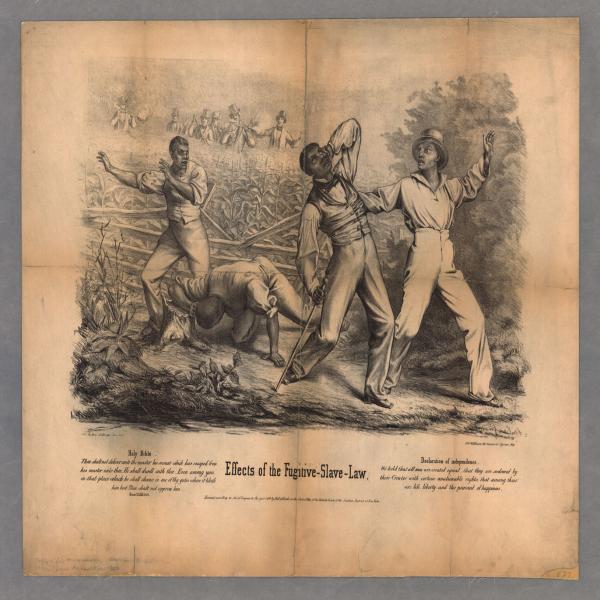Effects of the Fugitive Slave Law
Original

Background Notes
This image portrays what life would have been like for blacks in America after the Fugitive Slave Act was passed. It shows four blacks being shot by white men as they tried to escape their capture. What is important to note is that it is unknown if these black men were free or fugitives. To the white men, it wouldn’t have mattered, as they would have attempted to shoot and capture them anyway.
Mounting tensions between northerners and southerners over newly acquired territories in the west were very alarming to politicians in 1850. Senator Henry Clay introduced a series of laws designed to create a compromise between the north and the south in order to prevent the south from seceding from the Union. These resolutions came to be known as the Compromise of 1850. One of the resolutions to be passed was called the Fugitive Slave Act. This resolution was very controversial for many reasons. It forced citizens to assist in the recovery of fugitives, and if they were unwilling to assist or had aided a fugitive in escaping, they were subject to a fine and prosecution. Likewise, it denied fugitives who claimed to be freemen the right to a fair jury trial. Also, it put all fugitive cases under federal jurisdiction. This was devastating to free blacks living in the north, because they could no longer legally prove that they were free. Many were sent back into slavery in the south. Thousands of fugitives living in the north fled to Canada in order to escape being sent back into slavery. Southerners believed that the Compromise met its goals in stopping the south from seceding from the Union, at least temporarily. But the Compromise made northerners more determined to end slavery than ever. As a result, the Underground Railroad’s popularity rose to its peak during the following decade. (1)
Artist: Theodore Kaufman (1814- after 1887). Kaufman was born in Germany, immigrated to America, fought in the Civil War, and then lived in Boston. He is best known for his Civil War paintings. (2)
(1) Richard B. Morris, Encyclopedia of American History (New York: Harper & Bros., 1953), 210-213, 514-516
(2) Groce, George C. and David H. Wallace, The New York Historical Society’s Dictionary of Artists in America, 1564-1860 (New Haven: Yale University Press, 1957), 361.